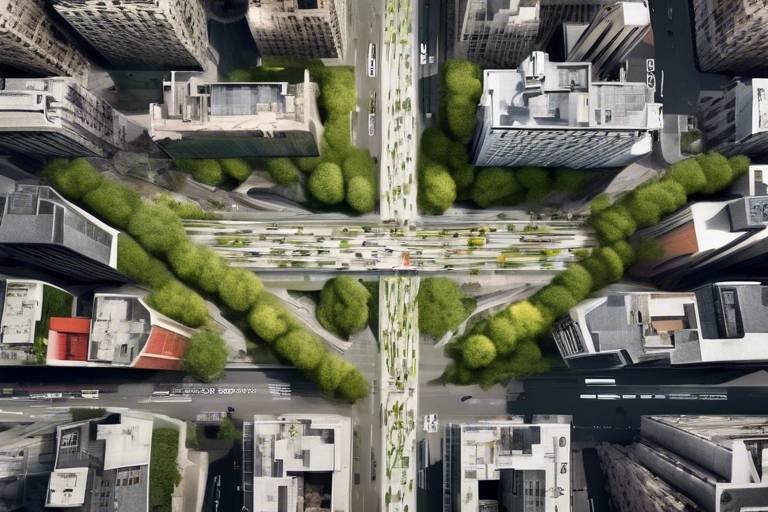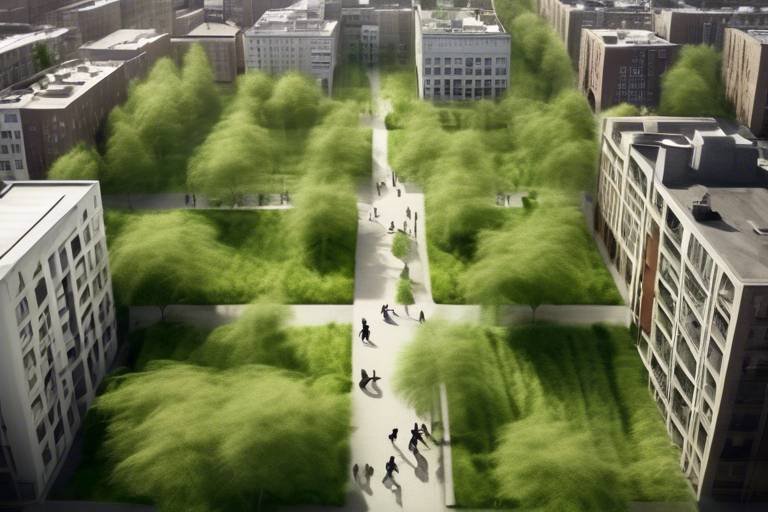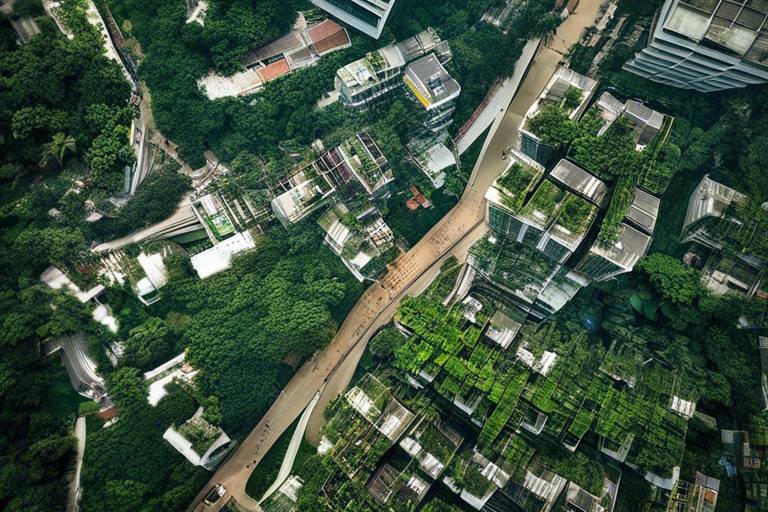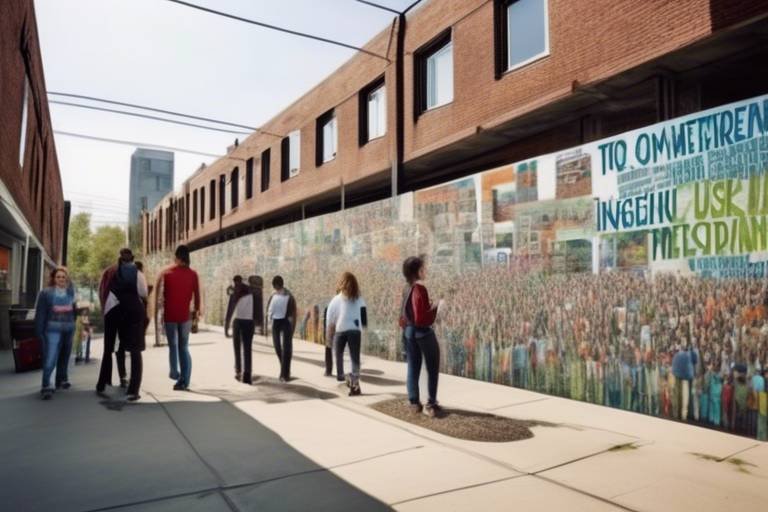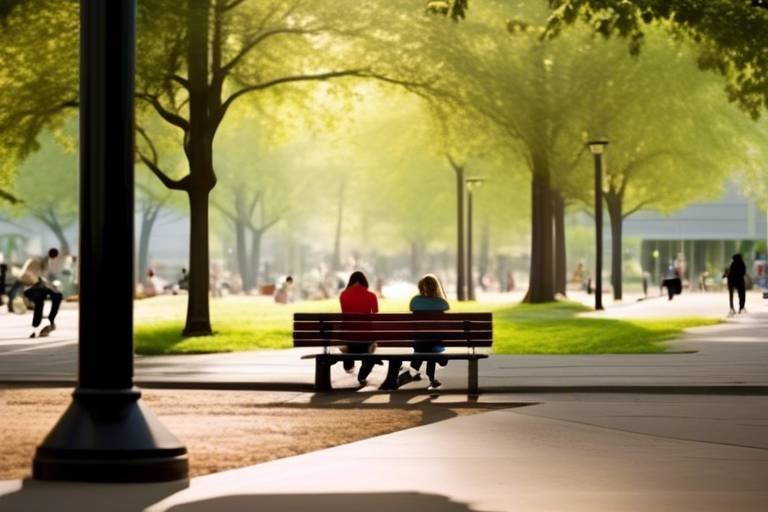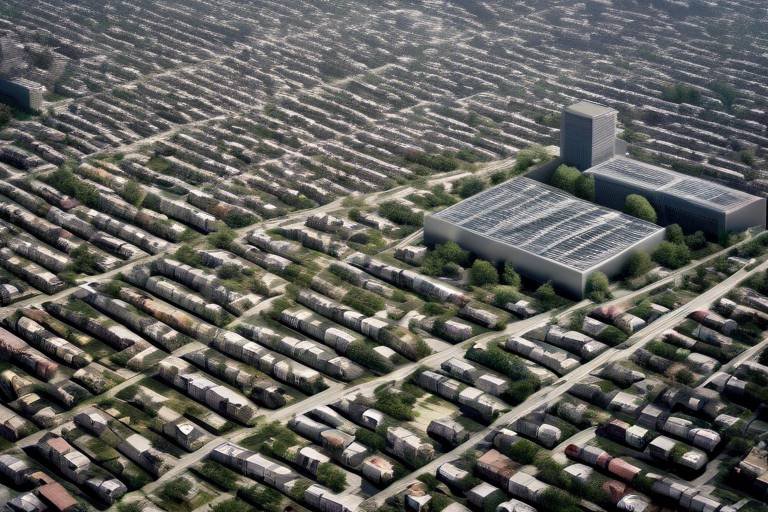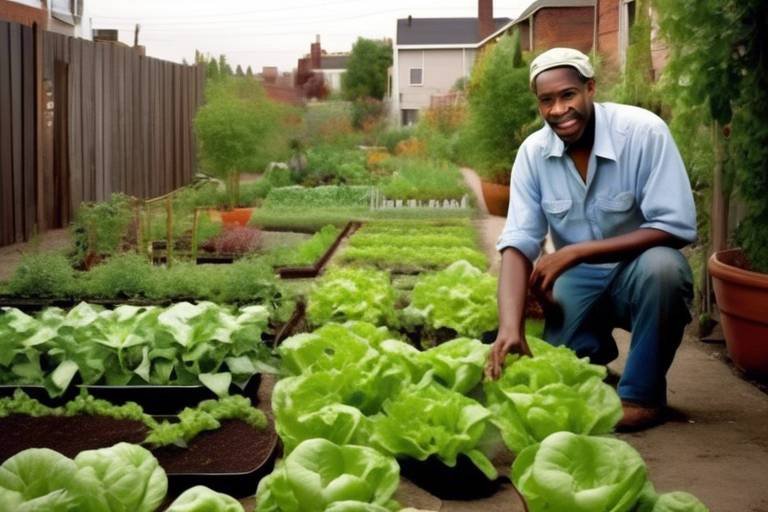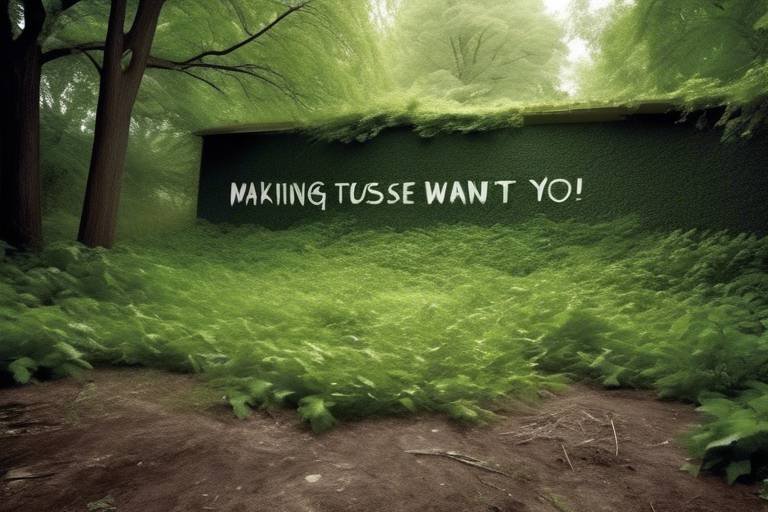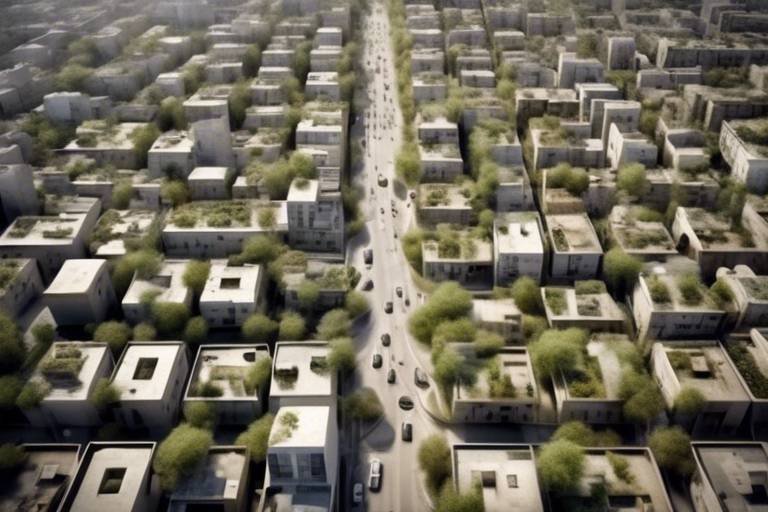The Importance of Sustainable Urban Design
Sustainable urban design is more than just a buzzword; it’s a vital approach to shaping our cities in a way that balances the needs of the environment, society, and the economy. As urban populations continue to swell, with projections indicating that nearly 68% of the world’s population will live in urban areas by 2050, the necessity for sustainable practices becomes increasingly urgent. Imagine cities that not only accommodate growing populations but also enhance the quality of life for all residents. This is the promise of sustainable urban design.
At its core, sustainable urban design integrates three critical pillars: environmental stewardship, social equity, and economic viability. These elements work together to create spaces that are not only functional but also resilient and inclusive. Think of it as a three-legged stool; if one leg is weak, the entire structure becomes unstable. Thus, it is essential that urban planners and designers consider all three aspects to ensure that our cities can thrive now and in the future.
Moreover, the impact of sustainable urban design extends beyond mere aesthetics. It addresses pressing environmental challenges, such as climate change and resource depletion, while promoting social cohesion and community well-being. For instance, cities designed with ample green spaces and efficient public transportation systems not only reduce carbon footprints but also encourage healthier lifestyles among residents. When people can walk or bike to work, they are not just reducing their environmental impact; they are also improving their physical and mental health.
Furthermore, sustainable urban design fosters community engagement and participation. By involving residents in the planning process, cities can create spaces that genuinely reflect the needs and desires of their communities. This participatory approach helps to build a sense of ownership and pride among residents, making them more likely to take care of their neighborhoods. It’s like a potluck dinner; when everyone contributes their favorite dish, the meal is not only more diverse but also more enjoyable for all.
In conclusion, the importance of sustainable urban design cannot be overstated. It is a holistic approach that addresses the multifaceted challenges of urban living while promoting a healthier, more equitable, and resilient future. As we continue to innovate and adapt our cities to the changing world, embracing sustainable practices will be key to ensuring that they remain vibrant places for generations to come.
- What is sustainable urban design?
Sustainable urban design integrates environmental, social, and economic factors to create livable, resilient cities. - Why is sustainable urban design important?
It helps address environmental challenges, promotes social equity, and enhances the quality of life in urban areas. - What are some examples of sustainable urban design?
Examples include green roofs, parks, efficient public transportation, and mixed-use developments. - How can communities get involved in sustainable urban design?
Communities can participate through public consultations, workshops, and advocacy for sustainable practices.

Understanding Sustainable Urban Design
Sustainable urban design is not just a buzzword; it's a vital approach that integrates various aspects of urban living to create spaces that are not only functional but also environmentally friendly and socially inclusive. Imagine a city where parks are abundant, public transport is efficient, and every resident has access to essential services. This vision is what sustainable urban design strives to achieve. It harmonizes environmental, social, and economic factors, ensuring that cities are resilient and capable of adapting to future challenges.
At its core, sustainable urban design focuses on enhancing the quality of life for all urban residents. This means considering how people live, work, and interact with their environment. It’s about creating spaces that promote sustainability and resilience, which can be likened to planting a seed that grows into a robust tree, providing shade and shelter for the community. To accomplish this, urban planners and designers employ various strategies, including:
- Green Spaces: Parks and gardens that not only beautify the city but also improve air quality and provide recreational areas.
- Efficient Resource Use: Utilizing materials and energy in a way that minimizes waste and maximizes efficiency.
- Community Engagement: Involving residents in the planning process to ensure their needs and preferences are met.
Furthermore, sustainable urban design is about creating a sense of place. It involves understanding the unique characteristics of a community and respecting its cultural heritage. This approach helps foster a sense of belonging among residents, making them feel more connected to their environment. Think of it as crafting a mosaic where each piece represents a different aspect of the community, coming together to form a beautiful, cohesive picture.
In addition to these principles, it’s essential to recognize the role of technology in sustainable urban design. Innovations such as smart grids, energy-efficient buildings, and sustainable transportation systems are becoming integral to urban planning. These technologies not only enhance the functionality of urban spaces but also contribute to reducing the overall environmental footprint of cities.
Ultimately, understanding sustainable urban design is about recognizing its multifaceted nature. It requires collaboration among various stakeholders, including government, private sectors, and local communities, to create urban environments that are not only livable today but also sustainable for future generations. By embracing this holistic approach, we can cultivate cities that thrive on sustainability, resilience, and inclusivity.
What is sustainable urban design?
Sustainable urban design is an approach that integrates environmental, social, and economic factors to create livable, resilient cities.
Why is sustainable urban design important?
It is crucial for reducing environmental impact, improving public health, and promoting social equity, making urban areas more vibrant and livable.
How does community engagement play a role in sustainable urban design?
Engaging communities ensures that urban spaces reflect the values and needs of residents, fostering a sense of ownership and belonging.
What are some challenges in implementing sustainable urban design?
Challenges include funding constraints, political resistance, and the need for public awareness and engagement.

Benefits of Sustainable Urban Design
Implementing sustainable urban design principles is like planting seeds for a flourishing garden; the benefits blossom over time, creating a vibrant ecosystem that enriches the lives of urban residents. One of the most significant advantages is the reduction of environmental impact. By prioritizing green spaces and eco-friendly materials, cities can dramatically lower their carbon footprints, contributing to a healthier planet. Imagine walking through a city where the air feels fresher, the temperatures are moderated by trees, and the sound of nature replaces the constant hum of traffic. This is not just a dream; it’s a reality made possible through sustainable urban design.
Another crucial benefit is the improvement of public health. Urban areas designed with sustainability in mind often feature pedestrian-friendly pathways, bike lanes, and accessible public transportation. This encourages residents to engage in more physical activities, reducing obesity rates and enhancing overall health. Furthermore, with increased green spaces, communities can enjoy cleaner air and reduced heat, which are vital for mental and physical well-being. Just think about how a simple park can become a sanctuary for relaxation and community gathering, helping to foster connections among residents.
Moreover, sustainable urban design enhances community cohesion. When cities invest in inclusive public spaces, they create opportunities for social interaction, cultural exchange, and community events. These spaces are essential for building relationships among diverse groups, promoting a sense of belonging. For instance, community gardens not only provide fresh produce but also serve as a meeting point for neighbors to collaborate, share stories, and strengthen their ties. In this way, sustainable urban design acts as a catalyst for vibrant, interconnected communities.
Additionally, consider the economic benefits; sustainable urban design can lead to increased property values and attraction of businesses. When neighborhoods are well-planned, with access to amenities and efficient transportation, they become desirable places to live and work. A well-designed urban environment can stimulate local economies, providing jobs and fostering entrepreneurship. In essence, investing in sustainable urban design is investing in the future of the city, creating a win-win scenario for residents, businesses, and the environment alike.
In summary, the benefits of sustainable urban design extend far beyond aesthetics. They encompass environmental, health, and social dimensions that contribute to the overall quality of life in urban settings. By embracing these principles, cities can create not just livable spaces but thriving communities that are resilient and prepared for the challenges of tomorrow.
- What is sustainable urban design? Sustainable urban design integrates environmental, social, and economic factors to create spaces that promote sustainability and resilience.
- How does sustainable urban design benefit public health? It encourages physical activity through pedestrian-friendly designs and improves air quality with green spaces.
- Can sustainable urban design help with climate change? Yes, by reducing carbon footprints and promoting green infrastructure, it contributes to climate resilience.
- What role does community engagement play in sustainable urban design? Engaging the community ensures that urban spaces reflect the needs and values of residents, leading to more successful projects.

Environmental Impact
Sustainable urban design plays a pivotal role in minimizing the of cities. By integrating eco-friendly practices into urban planning, we can significantly reduce our ecological footprint. One of the primary ways this is achieved is through the promotion of green spaces, which are essential for maintaining biodiversity and improving air quality. Imagine a city where parks and gardens are not just afterthoughts but integral parts of the urban landscape, providing habitats for wildlife and recreational areas for residents. This vision is not just a dream; it's a necessity for our planet's health.
Furthermore, sustainable urban design emphasizes the efficient use of resources. This involves implementing strategies that reduce energy consumption and promote renewable energy sources. For instance, buildings designed with energy efficiency in mind can drastically lower greenhouse gas emissions. Think of it as upgrading your home with energy-saving appliances—only on a much larger scale. When cities adopt such practices, they not only decrease their carbon footprint but also save money in the long run.
Another critical aspect of sustainable urban design is the incorporation of biodiversity. By creating habitats within urban areas, cities can support various species that might otherwise struggle to survive. This approach fosters a more resilient ecosystem, which is crucial in the face of climate change. For example, urban forests and green roofs can provide shelter for birds and insects, contributing to a balanced urban ecosystem.
To illustrate the positive environmental impacts of sustainable urban design, here’s a simple table that highlights key benefits:
| Benefit | Description |
|---|---|
| Reduced Urban Heat | Green spaces help lower temperatures in urban areas, combating the heat island effect. |
| Improved Air Quality | Plants filter pollutants and produce oxygen, leading to cleaner air. |
| Biodiversity Enhancement | Urban green areas provide habitats for various species, promoting ecological balance. |
In addition to these benefits, effective water management strategies are crucial in sustainable urban design. Techniques such as rain gardens and permeable pavements not only reduce flooding risks but also promote water conservation. By allowing rainwater to infiltrate the ground rather than running off into storm drains, we can replenish groundwater supplies and reduce the burden on urban drainage systems. Imagine a city where rainfall is not seen as a nuisance but as a resource to be harnessed! This shift in perspective is essential for creating resilient urban environments that can adapt to changing climate conditions.
In conclusion, the environmental impact of sustainable urban design is profound. By prioritizing green infrastructure, resource efficiency, and biodiversity, we can create urban spaces that not only enhance our quality of life but also protect our planet for future generations. The question remains: are we ready to embrace these changes and transform our cities into sustainable havens? The answer lies in our collective commitment to innovative planning and community engagement.
- What is sustainable urban design? Sustainable urban design integrates environmental, social, and economic factors to create spaces that promote sustainability and enhance the quality of life in urban areas.
- How does sustainable urban design benefit the environment? It reduces ecological footprints, promotes biodiversity, improves air quality, and enhances resource efficiency, contributing to healthier ecosystems.
- What are some examples of sustainable urban design practices? Examples include green roofs, urban parks, rain gardens, and the use of permeable pavements.
- Why is community engagement important in sustainable urban design? Engaging communities ensures that urban spaces reflect the values and aspirations of residents, leading to more effective and accepted design solutions.

Green Infrastructure
When we think about urban landscapes, it’s easy to imagine concrete jungles and bustling streets, but what if I told you that integrating into our cities could transform them into vibrant ecosystems? Green infrastructure encompasses a variety of natural and semi-natural systems that provide essential services, such as parks, green roofs, and urban forests. These elements not only beautify our surroundings but also play a crucial role in enhancing the quality of life for urban residents.
Imagine living in a city where the air is fresh, temperatures are moderated, and rainwater is effectively managed. This is the promise of green infrastructure. By incorporating parks and green spaces, cities can create natural cooling zones that combat the urban heat island effect, which often plagues densely populated areas. According to the Environmental Protection Agency (EPA), urban areas can be up to 5°F warmer than their rural counterparts, primarily due to human activities and the prevalence of concrete and asphalt. Green spaces help mitigate this issue, allowing residents to enjoy more comfortable outdoor conditions.
Moreover, green infrastructure contributes significantly to improving air quality. Plants absorb carbon dioxide and release oxygen, which is essential for our health. They also filter pollutants from the air, making it cleaner for everyone. For instance, a single large tree can absorb approximately 48 pounds of carbon dioxide per year while releasing enough oxygen to support two human beings. By incorporating more trees and green spaces into our urban designs, we not only enhance aesthetics but also promote healthier living environments.
In addition to these benefits, green infrastructure fosters community engagement. Parks and recreational areas serve as social hubs where people gather, interact, and build relationships. This sense of community is vital for social cohesion and can lead to a more engaged and active citizenry. When residents feel connected to their environment, they are more likely to take pride in their neighborhoods and participate in local initiatives.
Now, you might be wondering how cities can effectively implement green infrastructure. Here are some key strategies:
- Green Roofs: These are roofs covered with vegetation that help insulate buildings, reduce stormwater runoff, and improve air quality.
- Parks and Community Gardens: Creating accessible green spaces encourages community interaction and offers recreational opportunities.
- Permeable Pavements: These surfaces allow rainwater to infiltrate, reducing runoff and promoting groundwater recharge.
By adopting these strategies, cities can harness the power of nature to create healthier, more sustainable urban environments. The integration of green infrastructure is not merely an aesthetic choice; it is a necessity for fostering resilience against environmental challenges and improving the overall well-being of urban populations.

Water Management
Water management is a cornerstone of sustainable urban design, playing a pivotal role in how cities cope with the challenges posed by climate change and urbanization. As cities expand, the demand for water resources increases, making it essential to implement effective strategies that not only conserve water but also manage stormwater efficiently. By integrating innovative solutions like rain gardens, permeable pavements, and green roofs, urban planners can create systems that mimic natural processes, allowing water to be absorbed, filtered, and reused.
One of the most effective methods of water management is the use of rain gardens. These specially designed landscapes capture rainwater runoff from impervious surfaces like roofs and driveways. By allowing water to infiltrate the soil, rain gardens help to recharge groundwater supplies while also reducing the risk of flooding. Additionally, they provide habitat for local wildlife and enhance the aesthetic appeal of neighborhoods. Imagine walking through a community where vibrant flowers and lush greenery not only beautify the area but also serve a functional purpose in managing water. It’s a win-win!
Another essential element of water management is the implementation of permeable pavements. Unlike traditional concrete or asphalt, permeable pavements allow water to flow through their surface, reducing runoff and promoting groundwater recharge. This technology is particularly beneficial in urban areas where hard surfaces dominate, creating a natural filtration system that can help mitigate pollution. Picture a bustling city street where rainwater is absorbed into the ground rather than flooding the sidewalks—this is the future of urban design!
Furthermore, urban areas can benefit from comprehensive stormwater management systems that include retention basins and bioswales. Retention basins are designed to hold excess stormwater temporarily, allowing it to gradually infiltrate the ground or evaporate, while bioswales are landscape elements that direct and filter stormwater through vegetation and soil. These features not only reduce flooding but also enhance the local ecosystem by providing habitats for various species.
In conclusion, effective water management in sustainable urban design is not just about controlling water flow; it’s about creating a harmonious relationship between urban development and the natural environment. By prioritizing water management strategies, cities can ensure that they are resilient, sustainable, and capable of supporting the needs of their residents while protecting vital natural resources.
- What is sustainable urban design? Sustainable urban design focuses on creating urban environments that are environmentally friendly, socially equitable, and economically viable.
- How does water management contribute to sustainable urban design? It helps manage stormwater, reduces flooding risks, and promotes water conservation, ensuring a sustainable water supply for urban areas.
- What are rain gardens? Rain gardens are landscaped areas designed to capture and absorb rainwater runoff, helping to recharge groundwater and reduce flooding.
- Why are permeable pavements important? They allow rainwater to infiltrate the ground, reducing runoff and promoting groundwater recharge, which is crucial in urban areas.
- What role do communities play in sustainable urban design? Community engagement is vital for understanding local needs and ensuring that urban spaces reflect the values and aspirations of residents.

Social Equity
Sustainable urban design is not just about creating beautiful spaces; it's fundamentally about . Imagine a city where everyone, regardless of their background, has access to essential services, affordable housing, and vibrant public spaces. This is the vision that sustainable urban design strives to achieve. By prioritizing social equity, we can foster diverse and inclusive communities that genuinely reflect the values and aspirations of their residents.
One of the core principles of social equity in urban design is ensuring that all community members have equal access to resources and opportunities. This includes not only housing and transportation but also parks, schools, and healthcare facilities. When we design urban spaces with equity in mind, we create environments where everyone can thrive. For instance, consider the difference between a neighborhood with well-maintained parks and recreational areas and one that lacks such amenities. The former encourages community interaction, promotes physical health, and enhances overall quality of life.
Furthermore, sustainable urban design actively seeks to engage marginalized communities in the planning process. This engagement is essential for understanding local needs and preferences. By involving residents in discussions about their neighborhoods, we can ensure that urban spaces are not only functional but also resonate with the people who live there. This collaborative approach can lead to innovative solutions that might not have been considered otherwise.
To illustrate the importance of social equity in urban design, let's look at some key factors:
- Access to Public Transportation: Ensuring that all neighborhoods are connected to public transit can significantly improve access to jobs and services.
- Affordable Housing: Integrating affordable housing options within all neighborhoods prevents economic segregation and promotes diversity.
- Inclusive Public Spaces: Designing parks and community centers that cater to all ages and abilities fosters a sense of belonging.
In summary, social equity is a vital component of sustainable urban design. By prioritizing inclusivity and accessibility, we can create cities that are not only livable but also equitable for all residents. The question we must ask ourselves is: how can we ensure that our urban environments reflect the diversity and needs of our communities? The answer lies in our commitment to engaging with and empowering every voice in the urban design process.
- What is sustainable urban design?
Sustainable urban design integrates environmental, social, and economic factors to create spaces that promote sustainability, resilience, and quality of life for all urban residents. - How does social equity relate to urban design?
Social equity ensures that all community members have access to essential services, affordable housing, and inclusive public spaces, fostering diverse and vibrant communities. - What are some challenges in implementing sustainable urban design?
Challenges include funding constraints, political resistance, and the need for public awareness and engagement.

Challenges in Implementing Sustainable Urban Design
Implementing sustainable urban design is akin to trying to steer a massive ship through a narrow strait; it requires precision, collaboration, and often, a bit of patience. Despite its undeniable benefits, the path to creating sustainable urban environments is riddled with challenges that can impede progress. One of the foremost obstacles is funding constraints. Many innovative urban design projects require significant investment, and securing this funding can be a daunting task. Local governments often face tight budgets, making it difficult to allocate resources for sustainable initiatives. This is where collaboration becomes essential. By forming partnerships between the government, private sector, and community stakeholders, cities can pool resources and share the financial burden of sustainable projects.
Another major hurdle is political resistance. Urban design is often influenced by political agendas, and sustainable initiatives may not always align with the interests of those in power. For instance, the push for green spaces or bike lanes might be met with opposition from developers who prioritize profit over environmental considerations. This conflict can delay or even derail projects that would benefit the community in the long run. It’s crucial for advocates of sustainable urban design to engage with policymakers and demonstrate the long-term benefits of these initiatives, not just for the environment but also for the economy and public health.
Moreover, there’s a pressing need for public awareness and engagement. Many people are unaware of the principles of sustainable urban design and how it can enhance their quality of life. Without public support, initiatives may struggle to gain traction. Engaging the community through workshops, public forums, and social media campaigns can help raise awareness and foster a sense of ownership among residents. When people feel a connection to their urban environment, they are more likely to support sustainable initiatives and advocate for their implementation.
To illustrate these challenges further, let's take a look at a table summarizing the main obstacles faced in implementing sustainable urban design:
| Challenge | Description |
|---|---|
| Funding Constraints | Limited financial resources make it difficult to support sustainable projects. |
| Political Resistance | Conflicts with political agendas can hinder the progress of sustainable initiatives. |
| Public Awareness | Lack of understanding about sustainable design principles can lead to low community support. |
In summary, while the goal of sustainable urban design is to create more livable and equitable cities, the journey is fraught with challenges. From securing funding and navigating political landscapes to engaging the community, each step requires careful consideration and collaboration. Overcoming these hurdles is essential for fostering urban environments that not only meet the needs of today but also ensure a sustainable future for generations to come.
- What is sustainable urban design? Sustainable urban design integrates environmental, social, and economic factors to create resilient and livable urban spaces.
- Why is funding a challenge in sustainable urban design? Many projects require significant investment, and local governments often operate under tight budgets, making it difficult to allocate resources.
- How can communities get involved in sustainable urban design? Communities can participate through public forums, workshops, and advocacy efforts to ensure their needs and values are represented in urban planning.
- What are some examples of sustainable urban design initiatives? Examples include green roofs, urban parks, bike lanes, and efficient public transportation systems.

Funding and Resources
Securing adequate funding and resources is a pivotal aspect of implementing sustainable urban design projects. Without proper financial backing, even the most innovative ideas can remain just that—ideas. The challenge often lies in the multifaceted nature of urban design, which requires collaboration across various sectors. Local governments, private investors, and community organizations must come together to pool resources and share the financial burden. This collaboration not only facilitates the flow of funds but also fosters a sense of shared responsibility among stakeholders.
Moreover, public-private partnerships have emerged as a significant avenue for financing sustainable urban projects. For instance, when a city collaborates with a private developer to create a green space, both parties can benefit. The developer gains a positive public image and potential tax incentives, while the city enhances its livability and environmental quality. This synergy is crucial for realizing ambitious urban design goals.
Another vital source of funding comes from grants and subsidies offered by governmental and non-governmental organizations. These funds can support various aspects of sustainable design, from research and development to actual construction and maintenance of green infrastructure. Cities that actively seek out these opportunities often find themselves at the forefront of sustainable innovation.
In addition, community involvement plays a significant role in securing resources. When residents are engaged in the planning process, they are more likely to advocate for funding and support initiatives that reflect their needs and desires. This grassroots approach can lead to successful fundraising campaigns, whether through crowdfunding platforms or local fundraising events. The more invested the community is, the more likely they are to see projects through to completion.
To illustrate the various funding sources available for sustainable urban design, the table below outlines different avenues and their potential benefits:
| Funding Source | Description | Potential Benefits |
|---|---|---|
| Public-Private Partnerships | Collaboration between government and private entities. | Shared financial responsibility, enhanced project visibility. |
| Grants and Subsidies | Financial aid from government or NGOs. | Supports innovative projects, reduces financial risk. |
| Community Fundraising | Local efforts to raise money for projects. | Increased community engagement, tailored projects. |
In conclusion, while the challenges of funding and resources in sustainable urban design are significant, they are not insurmountable. By fostering collaboration among stakeholders, leveraging available funding opportunities, and engaging the community, cities can pave the way for innovative and sustainable urban environments that benefit everyone.
- What are the main sources of funding for sustainable urban design?
The main sources include public-private partnerships, grants and subsidies, and community fundraising efforts.
- How can community engagement improve funding opportunities?
When communities are involved in the planning process, they are more likely to advocate for funding and support initiatives that meet their needs.
- What role do local governments play in sustainable urban design funding?
Local governments often act as facilitators, providing resources, support, and sometimes funding to ensure successful project implementation.

Community Engagement
When it comes to sustainable urban design, is not just a buzzword—it's a vital ingredient for success. Imagine trying to bake a cake without knowing your guests' favorite flavors; the result might be a delicious disaster! Similarly, urban planners must understand the unique needs and desires of the communities they serve. By actively involving residents in the design process, cities can create spaces that truly resonate with the people who inhabit them.
Engagement can take various forms, from public meetings and workshops to online surveys and social media campaigns. Each method offers a platform for residents to voice their opinions, share their experiences, and contribute ideas. This two-way communication not only empowers community members but also provides valuable insights for planners. When people feel heard, they are more likely to take ownership of their environment and participate in its upkeep.
Moreover, community engagement fosters a sense of belonging and identity. When residents collaborate on projects that reflect their values and culture, it strengthens social ties and enhances community cohesion. Think of it as a neighborhood potluck, where everyone brings a dish that represents their heritage. The result is a vibrant tapestry of flavors and stories, much like a well-designed urban space that celebrates its diverse inhabitants.
However, engaging communities is not without its challenges. Different demographics may have varying levels of interest or ability to participate, and some voices may be louder than others. To address this, planners can employ inclusive strategies that ensure all community members have a seat at the table. This might include providing translation services, holding meetings at accessible times, or utilizing technology to reach a broader audience.
Incorporating community feedback into urban design can lead to innovative solutions that address local issues. For instance, a neighborhood plagued by traffic congestion might benefit from input on bike lanes or pedestrian walkways. By listening to the community, planners can create spaces that not only look good on paper but also function effectively in real life.
In conclusion, community engagement is the heartbeat of sustainable urban design. It transforms planning from a top-down approach into a collaborative effort that respects and reflects the voices of the residents. As cities continue to evolve, embracing this participatory mindset will be crucial in fostering environments that are not only sustainable but also livable and loved by their communities.
- Why is community engagement important in urban design?
Community engagement ensures that the voices of residents are heard, leading to designs that reflect their needs and enhance their quality of life. - How can communities get involved in urban design projects?
Communities can participate through public meetings, surveys, and online platforms where they can share their ideas and feedback. - What challenges do planners face in engaging communities?
Planners may encounter issues such as varying levels of interest among residents, accessibility barriers, and the need to ensure diverse voices are represented. - What are some successful examples of community engagement in urban design?
Many cities have seen positive outcomes from community-led initiatives, such as parks designed with input from local residents or housing projects that prioritize affordable options based on community feedback.

Future Trends in Sustainable Urban Design
As we look to the future, the landscape of urban design is rapidly evolving, driven by the pressing need for sustainability and resilience. One of the most exciting trends is the integration of smart technology into urban environments. Imagine walking through a city where traffic lights adapt in real-time to reduce congestion, or where sensors monitor air quality and adjust nearby green spaces accordingly. These innovations not only enhance the efficiency of urban systems but also improve the overall quality of life for residents. By harnessing data and technology, cities can become more responsive to the needs of their inhabitants, paving the way for a truly smart urban future.
Another notable trend is the emphasis on regenerative practices. Unlike traditional sustainability, which often focuses on minimizing harm, regenerative design aims to improve and restore the ecological health of urban areas. This can involve creating urban farms that not only provide fresh produce but also enhance biodiversity and soil health. Cities are increasingly recognizing that urban spaces can be productive and beneficial to the environment, rather than merely existing as places of consumption. For instance, projects that incorporate vertical gardens or urban forests can significantly contribute to carbon sequestration, making cities not just less harmful but actively beneficial to the planet.
Moreover, the concept of 15-minute cities is gaining traction. This innovative approach ensures that all essential services—such as grocery stores, schools, parks, and healthcare—are within a 15-minute walk or bike ride from home. This trend promotes a more connected and cohesive community, reducing reliance on cars and encouraging healthier lifestyles. Imagine a city where you can grab a coffee, pick up groceries, and attend a yoga class, all within a short stroll from your front door. This not only fosters community engagement but also significantly reduces carbon footprints.
In addition to these trends, community-led design is becoming increasingly important. Cities are recognizing that the best solutions come from those who live in them. Engaging residents in the planning process ensures that urban spaces reflect the unique needs and desires of the community. This participatory approach not only empowers citizens but also creates a sense of ownership and pride in local developments. By listening to voices from all walks of life, urban planners can create spaces that are truly inclusive and equitable.
Lastly, as climate change continues to pose significant challenges, the need for climate resilience in urban design is more critical than ever. Cities are beginning to adopt strategies that prepare for and adapt to the impacts of climate change, such as rising sea levels and increased flooding. This includes designing buildings that can withstand extreme weather events and creating green spaces that absorb stormwater. The focus is shifting from merely responding to climate-related issues to proactively designing urban environments that can thrive amidst these challenges.
- What is sustainable urban design?
Sustainable urban design integrates environmental, social, and economic factors to create spaces that promote sustainability, resilience, and quality of life for all urban residents. - Why is community engagement important in urban design?
Engaging communities ensures that urban spaces reflect local needs and values, fostering a sense of ownership and pride among residents. - What are 15-minute cities?
15-minute cities are urban areas where all essential services are within a 15-minute walk or bike ride, promoting healthier lifestyles and reducing car dependency. - How does smart technology contribute to sustainable urban design?
Smart technology enhances the efficiency of urban systems, making cities more responsive to the needs of their inhabitants.
Frequently Asked Questions
- What is sustainable urban design?
Sustainable urban design is a planning approach that integrates environmental, social, and economic factors to create urban spaces that are livable, resilient, and equitable. It focuses on reducing ecological footprints while enhancing the quality of life for all residents.
- Why is sustainable urban design important?
This design approach is crucial because it addresses pressing environmental challenges, promotes social equity, and improves public health. By implementing sustainable practices, cities can become more vibrant and livable, benefiting both current and future generations.
- How does sustainable urban design benefit the environment?
Sustainable urban design minimizes environmental impact by promoting green infrastructure, efficient resource use, and biodiversity. This leads to healthier ecosystems, improved air quality, and increased climate resilience, ultimately benefiting urban populations.
- What are some examples of green infrastructure?
Examples of green infrastructure include parks, green roofs, rain gardens, and permeable pavements. These features help mitigate urban heat, manage stormwater, and provide recreational spaces, enhancing community engagement and environmental quality.
- How does sustainable urban design promote social equity?
Sustainable urban design prioritizes social equity by ensuring access to essential services, affordable housing, and inclusive public spaces. This fosters diverse communities and ensures that all residents have a voice in the planning process.
- What challenges are faced in implementing sustainable urban design?
Some challenges include funding constraints, political resistance, and the need for public awareness and engagement. Overcoming these obstacles often requires collaboration among government, private sector, and community stakeholders.
- How can communities engage in the sustainable urban design process?
Communities can engage by participating in public meetings, providing feedback on design proposals, and collaborating with planners and designers. This involvement ensures that urban spaces reflect the values and aspirations of local residents.
- What are the future trends in sustainable urban design?
Emerging trends include the integration of smart technologies and regenerative practices, which offer innovative solutions for creating resilient and adaptive urban environments. These advancements aim to enhance sustainability and improve overall urban living conditions.

